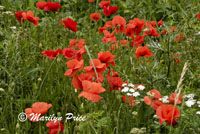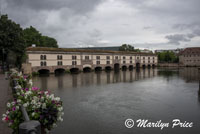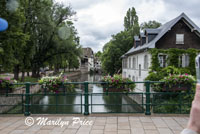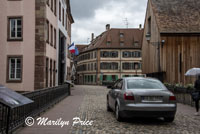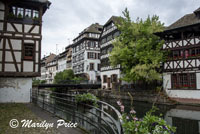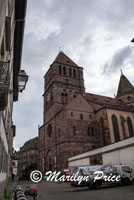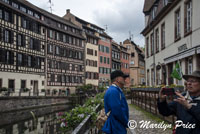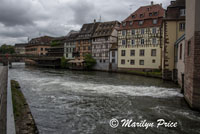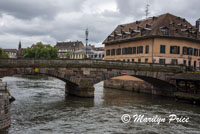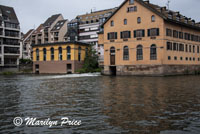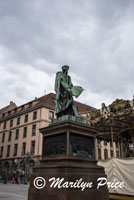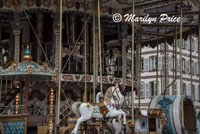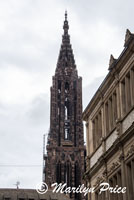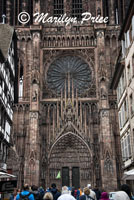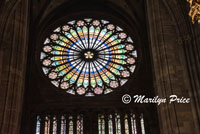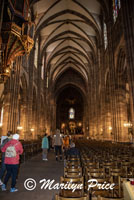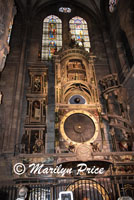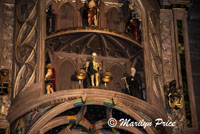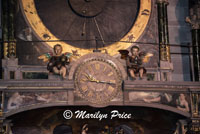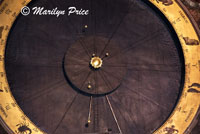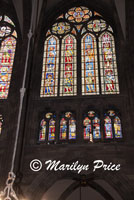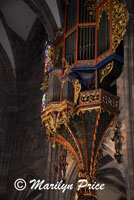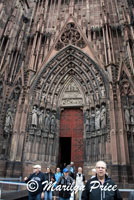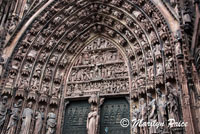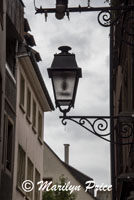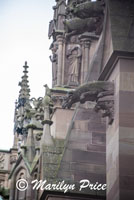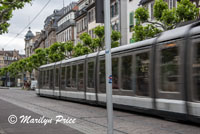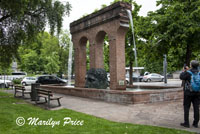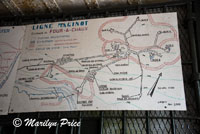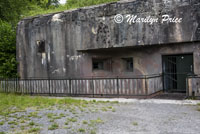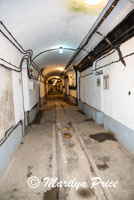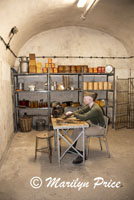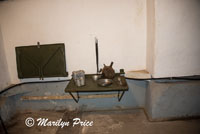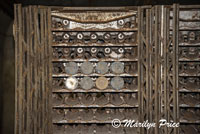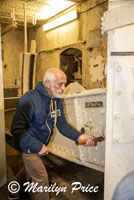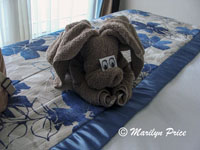May 31
June 1
June 2
June 3
June 4
June 5
June 6
June 7
June 8
June 9
June 10
June 11
June 12
Thursday June 6
Today is the anniversary of D-Day. On today's schedule is Strasbourg in the morning and the Maginot Line this afternoon.
It seems appropriate that the first thing I spotted when stepping off the ship this morning was a field of red poppies. Between the Maginot Line (between World Wars) visit this afternoon and the fact that it's D-Day, well....
It was a busy day. We had drizzle off and on in the morning. It was much cooler than the last couple of days. Only in the high 60s, rather than the low 90s.
We had a good walking tour of Strasbourg, a city that has been Roman, independent, German, French, German again, now French. They've redirected a part of the Rhine to encircle the older part of town and have some canals built through the town, also. To make it more confusing, we weren't docked in France, but across the river in Germany. We had to take a bus into town.
The three photos above show some of the random buildings and sights spotted as we entered the old part of town.
The photo on the left shows some half-timbered buildings along one of the canals. The center photo shows an unidentified church along one of the streets. The photo on the right shows Carl listening to our guide with more half-timbered buildings on a canal in the background.
The photo on the left shows more half-timbered buildings along a canal. This canal has an elevation change that creates a millrace. The current off the millrace can be seen here. The center photo shows one of the many bridges in Strasbourg. The photo on the right shows the millrace water racing between two buildings. It actually passes through the bottom portion of one of the buildings, where the water power is used for something.
The photo on the left above is a statue of Gutenberg in Gutenberg Plaza. The center photo shows a carousel that was set up temporarily in Gutenberg Plaza. I've only seen these double decker carousels in France. I wonder if other countries have them? The photo on the right is our first good glimpse of the Cathedral steeple.
The Cathedral in Strasbourg was the tallest building in the world (at 461 feet) for about five centuries!
The photo on the left above shows the entrance to the Cathedral that we went in through. The green flag is what we were following - our guide held it aloft. Above the doors is the large rose window from the outside. The center photo shows the huge rose window for this cathedral, as seen from the inside. The photo on the right shows the view down the aisle of the central nave.
One of the highlights of this Cathedral is the enormous astronomical clock house in one wing. This is the third clock built in this location. The first was in the 14th century. This one was dedicated about 1843. It keeps track of "solar time", central European time, phases of the moon, and more. The three photos below show some of the details. In the center is a moon on a starfield. The moon rotates showing the current phase of the moon (full, half, etc).
.
.
The photo on the left details the ages of man. Every 15 minutes, the display will rotate a quarter turn, revealing the next age. It goes from an infant to an adult man (protrayed as a soldier - just leaving on the left), to an old man (just coming in on the right), to a corpse. The skeleton ruling over this procession rings its bells on the quarter hour. The center photo shows the clock displaying solar time and public time (central European). The gold hands are solar time and the silver hands are public time. The photo on the right displays the current relative positions of the planets known at the time, with the sun in the center. Earth has a tiny moon that also orbits it. This is ringed by the zodiac signs.
There was a lot more detail involved. For more information, check the wikipedia page....
The photo on the left above shows some of the stained glass windows that lined the nave. The center photo shows one set of organ pipes. A matching set was on the other side of the aisle. The photo on the right shows the door we exited through.
The photo to the left shows some of the intricate detail and carvings over one of the doors of the cathedral.
At this point, the formal part of the walking tour was finished. We had about half an hour to wander the area before meeting up again for the walk back to the bus that would drive us back to the ship.
These three photos are things that caught my eye as Carl and I wandered around the area. The photo on the left is an interesting building on the edge of the cathedral square. I think it was a hotel. The folded umbrellas are part of an open air restaurant. The umbrellas were down because it was raining... The center photo is an interesting lamp I found on one of the side streets. The photo on the right shows the gargoyles and flying buttresses at the side of the cathedral. If you look closely at the larger version of this, you can see that the gargoyle is dripping, showing that its primary function was as a downspout!
Soon it was time to assemble for the short walk back to the bus. And I continued to take pictures as we walked along... The photo on the left shows one of several modern trams that would pass us today. The deck on these is low enough that, when it stops, there inside floor is level with the platform. Yet the platforms are at sidewalk level! No steps at all.
The photo on the right is a modernistic fountain that we paused by. The central statue reminds me of Janus, the two faced god. However, our guide did not give us any information about it at all.
We were back aboard the ship for lunch, which had a French theme, then we were off again.
We had the same guide for the Maginot Line bunker as we had had this morning in Strasbourg. She's not bad.
It was a short bus ride from the ship to Lembach, France, where we were able to tour part of a bunker from the line of bunkers that made up the Maginot Line. The photo on the left shows a layout of this particular bunker. The photo on the right shows the main personnel entrance to the bunker, which was about 100 yards up the hillside from the ticket office. It was a fairly steep climb. I'm happy to report that I was huffing and puffing less than our guide....
The first part of the bunker contained living quarters, cooking facilities, and everything necessary for off-duty hours. The photo on the left above shows the long main corridor. Auxiliary rooms were off this corridor. The tracks in the middle channeled any accumulated moisture back to drainage holes. The center photo shows a food preparation and storage area. The kitchens were adjacent to this room. The photo on the right shows how meals were eaten. After collecting rations at the kitchen window, the soldiers would carry them to one of these pull-down tables located along the corridor. They decided not to waste space making a mess hall, so this was their solution.
Also along in here, but not pictured, were bunk rooms, medical facilities, dental facilities, etc. The enlisted bunk rooms had five sets of bunk beds (three high) in a room most of us would consider a cozy bedroom size. Non-commisioned officers had similarly sized rooms, but each held three sets of bunk beds (two high). Officers rooms were about half the size, but one person to a room.
We had problems hearing our guide on this tour as the audio units we were using were line of sight only. As soon as we entered some of the labyrinths in this bunker, the sound broke up and disappeared completely. And most of the rooms were too small for the full group to comfortably fit into at one time.
We soon reached the heart of the bunker, directly below one of the six big guns serviced by this bunker. While we weren't able to see the guns themselves, nor view the top outside of the bunker, we were able to see part of the works.
The photo on the left shows a rack of cannon shells with some of the slots occupied. These would be placed on a sort of elevator - more like a dumb waiter - which would lift them to the cannons from the armory. It was pointed out that the openings were exactly the same size as a wine bottle and, frequently, a wine bottle or two would accompany the shells to the men on duty.
From the armory level, we climbed stairs (close to 200 steps) to the bombadier level. The photo on the right shows one of the bunker's volunteers cranking the handle that aimed the cannon, which was still farther above us. It could be raised to firing position and rotated to aim it, all using these fairly easy to turn cranks.
Then back down the 200 steps to rejoin those of our group that passed on the stairs. From here, it was down another 150 or so steps to the entrance level. These stairs had no hand rail at all and were irregularly placed. They ran along the cog system that raised the shells from the entrance level, where trucks would deliver them, to the armory level. About half way down this long uneven stairway, the lights went out!!! Fortunately, they were back on very, very quickly, but it was very disconcerting, to say the least.
Then it was back to ship in time to shower and hit Happy Hour before dinner. We found this "puppy" made of towels by our nice room attendant waiting on our bed when we got there. I almost hated to break him up to use the towels!
Tonight was our Farewell Dinner, even though tomorrow is the last night. They didn't want to interfere with packing tomorrow night...
We had drinks in the Lounge after dinner with the Victoria couple (Mr. and Mrs. Economist – I forget their names). She's super intense and he's indulgent...
Now to bed. We have another busy day tomorrow. We're off to the Black Forest early.

